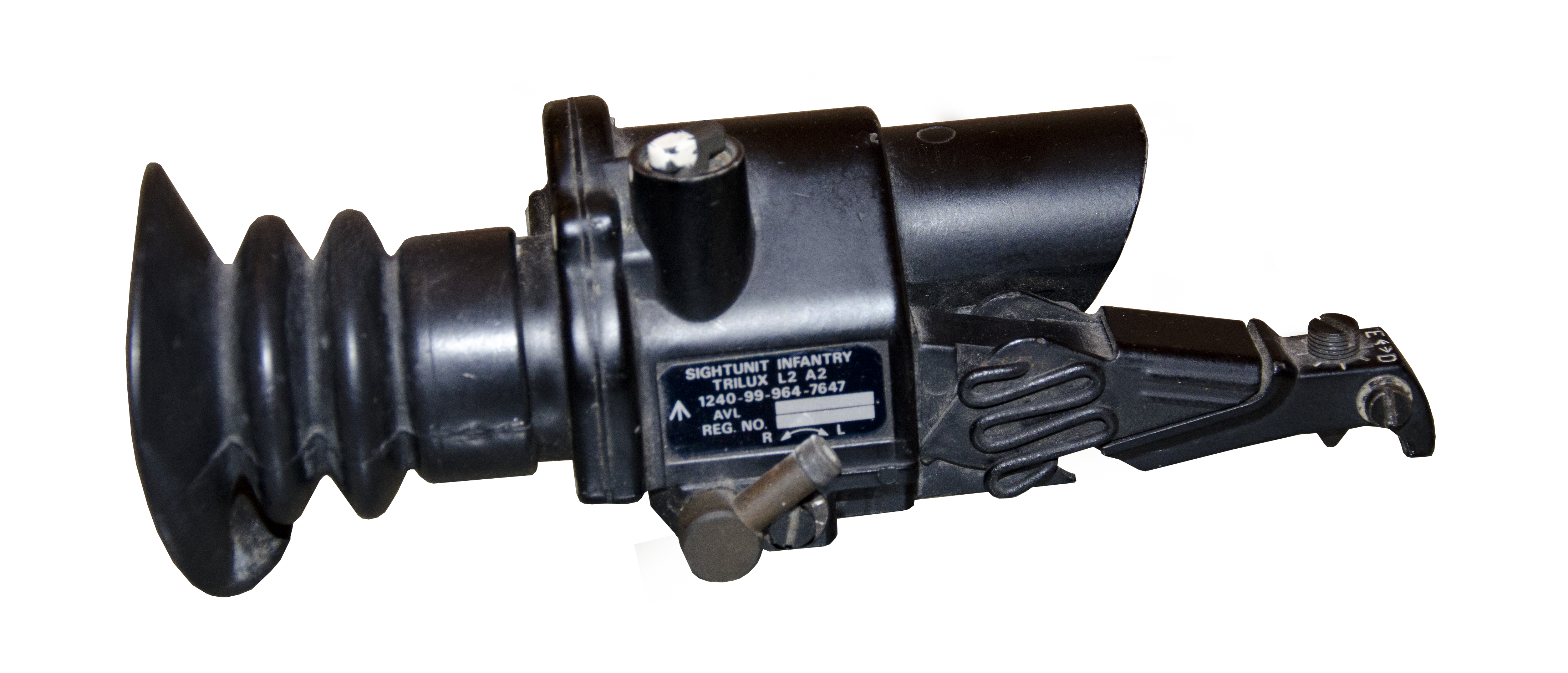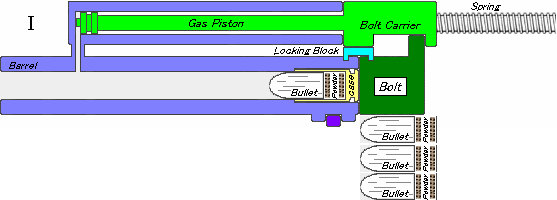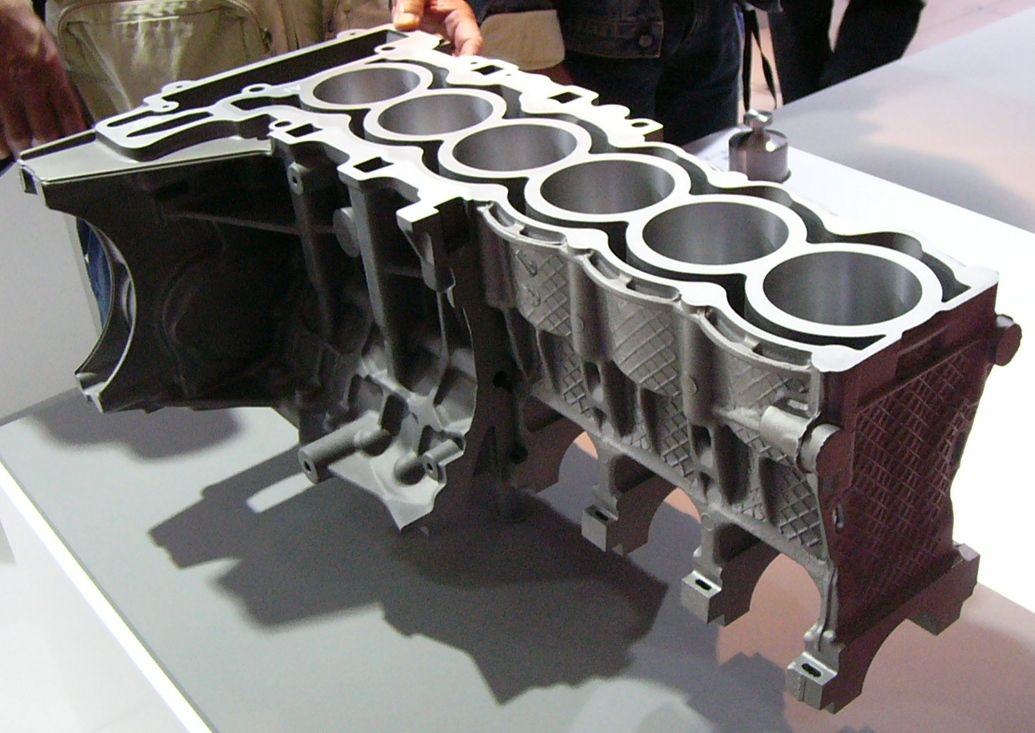|
SUSAT
{{Other uses, Susat (other){{!Susat The Sight Unit Small Arms, Trilux, or SUSAT, is a 4× telescopic sight, with tritium-powered illumination utilised at dusk or dawn. The full name of the current model is the SUSAT L9A1. The sight is not designed as a sniper sight, but is rather intended to be mounted on a variety of rifles and to be used by all infantrymen. A similar device is the Advanced Combat Optical Gunsight. Use SUSAT was the primary sighting system for the British Army's SA80 series weapons and L108 and L110 light machine guns. It was phased out and replaced by ACOG and ELCAN sight units during mid-life upgrade programmes. As of March 2019 it is still in use with much of the UK armed forces due to budgetary constraints. It is (or has been) also used by the armies of Cameroon, Oman, Spain and Sweden Sweden, formally the Kingdom of Sweden,The United Nations Group of Experts on Geographical Names states that the country's formal name is the Kingd ... [...More Info...] [...Related Items...] OR: [Wikipedia] [Google] [Baidu] |
SA80
The SA80 (Small Arms for the 1980s) is a British family of 5.56×45mm NATO service weapons used by the British Army. The L85 Rifle variant has been the standard issue service rifle of the British Armed Forces since 1987, replacing the L1A1 Self-Loading Rifle. The first prototypes were created in 1976, with production of the A1 variant starting in 1985 and ending in 1994. The A2 variant came to be as the result of a significant upgrade in the early 2000s by Heckler & Koch and remains in service as of 2020. The A3 variant was first issued in 2018 with several new improvements. The remainder of the SA80 family comprises the L86 Light Support Weapon, the short-barrelled L22 Carbine and the L98 Cadet rifle. The SA80 was the last in a long line of British weapons (including the Lee–Enfield family) to come from the Royal Small Arms Factory, the national arms development and production facility at Enfield Lock, before its weapons factory was closed down in 1988. Development Post ... [...More Info...] [...Related Items...] OR: [Wikipedia] [Google] [Baidu] |
Telescopic Sight
A telescopic sight, commonly called a scope informally, is an optical sighting device based on a refracting telescope. It is equipped with some form of a referencing pattern – known as a ''reticle'' – mounted in a focally appropriate position in its optical system to provide an accurate point of aim. Telescopic sights are used with all types of systems that require magnification in addition to reliable visual aiming, as opposed to non-magnifying iron sights, reflector (reflex) sights, holographic sights or laser sights, and are most commonly found on long-barrel firearms, particularly rifles, usually via a scope mount. The optical components may be combined with optoelectronics to add night vision or smart device features. History The first experiments directed to give shooters optical aiming aids go back to the early 17th century. For centuries, different optical aiming aids and primitive predecessors of telescopic sights were created that had practical or pe ... [...More Info...] [...Related Items...] OR: [Wikipedia] [Google] [Baidu] |
L2A2 SUIT Sight
The SUIT sight is a 4× telescopic sight with tritium-powered illumination, utilised at dusk or dawn. The full name is the L2A2 Sight Unit Infantry Trilux. The sight is not designed as a sniper sight, but as a standard issue infantry sight to improve the infantryman's night fighting capability and to assist target identification at long range in daylight and in poor light conditions. The sight was mounted on the L1A1 Self-Loading Rifle or GPMG. It was first produced in 1976 by Avimo Ltd. in London, England. Use The sight is an optional optical sighting system for the British Army's L1A1 Self-Loading Rifle and was also used by the Australians and New Zealanders. The sight has a lever to change between a short range mode (300 meters) and a long range mode (500 meters). A similar unit known as the SUSAT was fitted to the SA80 series weapons. Reticle The reticle of the SUIT sight is of unusual design. Unlike the traditional crosshair layouts commonly used, which are in essence a ... [...More Info...] [...Related Items...] OR: [Wikipedia] [Google] [Baidu] |
CETME Model L
The Model L is a Spanish 5.56×45mm NATO assault rifle developed in the late 1970s at the state-owned small arms research and development establishment CETME (''Centro de Estudios Técnicos de Materiales Especiales'') located in Madrid. The rifle retains many of the proven design elements the institute had used previously in its CETME Model 58 battle rifles.Woźniak, Ryszard. Encyklopedia najnowszej broni palnej - tom 1 A-F. Bellona. 2001. pp140-141. The weapon was successfully trialled between 1981–1982 and approved for serial production in 1984 at the Empresa Nacional Santa Bárbara factory (currently Santa Bárbara Sistemas, integrated into General Dynamics European Land Combat Systems division).Walter, John: ''Rifles of the World (3rd ed.)'', page 83. Krause Publications, 2006. The Model L replaced the 7.62mm CETME Model C in service with the Spanish Army and the first rifles were delivered in 1987, by which time orders for approximately 60,000 had been placed. From 1999 o ... [...More Info...] [...Related Items...] OR: [Wikipedia] [Google] [Baidu] |
Ak 5
The Ak 5 or ''Automatkarbin 5'' ("automatic carbine 5", "automatic carbine" being the Swedish term for assault rifle) is the Swedish version of the FN FNC assault rifle with certain modifications, mostly to adapt the weapon to the partially subarctic Swedish climate. The Ak 5 is the service rifle of the Swedish Armed Forces. The Ak 5 replaced the Ak 4 (a licensed-produced version of the Heckler & Koch G3) in Swedish service. Later versions also accept the Colt M203 grenade launcher attachment. The current standard issue version is the Ak 5C. In 2021, Sweden announced that they were looking to develop a new rifle in collaboration with Finland, which would replace the Ak 5. History In the mid-1970s, despite the failure of the ''Nytt infanterivapen'' (New Infantry Weapon) program, the Swedish Armed Forces decided to continue to follow the general transition towards smaller calibre ammunition and directed the Försvarets MaterielVerk (FMV) (Defence Materiel Administration) to pr ... [...More Info...] [...Related Items...] OR: [Wikipedia] [Google] [Baidu] |
Reticle
A reticle, or reticule also known as a graticule, is a pattern of fine lines or markings built into the eyepiece of an optical device such as a telescopic sight, spotting scope, theodolite, optical microscope or the screen of an oscilloscope, to provide measurement references during visual inspections. Today, engraved lines or embedded fibers may be replaced by a digital image superimposed on a screen or eyepiece. Both terms may be used to describe any set of patterns used for aiding visual measurements and calibrations, but in modern use ''reticle'' is most commonly used for weapon sights, while ''graticule'' is more widely used for non-weapon measuring instruments such as oscilloscope display, astronomic telescopes, microscopes and slides, surveying instruments and other similar devices. There are many variations of reticle pattern; this article concerns itself mainly with the most rudimentary reticle: the crosshair. Crosshairs are typically represented as a pair of perp ... [...More Info...] [...Related Items...] OR: [Wikipedia] [Google] [Baidu] |
FN Minimi
The FN Minimi (short for french: Mini Mitrailleuse; "mini machine gun") is a Belgian 5.56mm light machine gun/squad automatic weapon developed by Ernest Vervier for FN Herstal. First introduced in the late 1970s, it is now in service in more than 75 countries. The weapon is currently manufactured at the FN facility in Herstal and their U.S. subsidiary FN Manufacturing LLC. The Minimi fires from an open bolt. It is an air-cooled, gas operated long-stroke piston weapon that is capable of fully automatic fire only. It can be belt fed or fired from a magazine. The Minimi is configured in several variants: the Standard model as a platoon or squad support weapon, the Para version for paratroopers and the Vehicle model as secondary armament for fighting vehicles. Design details Operating mechanism The Minimi uses a gas-actuated long-stroke piston system. The barrel is locked with a rotary bolt, equipped with two massive locking lugs, forced into battery by a helical camming guide ... [...More Info...] [...Related Items...] OR: [Wikipedia] [Google] [Baidu] |
British Army
The British Army is the principal land warfare force of the United Kingdom, a part of the British Armed Forces along with the Royal Navy and the Royal Air Force. , the British Army comprises 79,380 regular full-time personnel, 4,090 Gurkhas, and 28,330 volunteer reserve personnel. The modern British Army traces back to 1707, with antecedents in the English Army and Scots Army that were created during the Restoration in 1660. The term ''British Army'' was adopted in 1707 after the Acts of Union between England and Scotland. Members of the British Army swear allegiance to the monarch as their commander-in-chief, but the Bill of Rights of 1689 and Claim of Right Act 1689 require parliamentary consent for the Crown to maintain a peacetime standing army. Therefore, Parliament approves the army by passing an Armed Forces Act at least once every five years. The army is administered by the Ministry of Defence and commanded by the Chief of the General Staff. The Brit ... [...More Info...] [...Related Items...] OR: [Wikipedia] [Google] [Baidu] |
Advanced Combat Optical Gunsight
The Advanced Combat Optical Gunsight (ACOG) is a series of prismatic telescopic sights manufactured by Trijicon. The ACOG was originally designed to be used on the M16 rifle and M4 carbine, but Trijicon has also developed ACOG accessories for other firearms. Models provide fixed-power magnification levels from 1.25× to 6×. ACOG reticles are illuminated at night by an internal tritium phosphor. Some versions have an additional daytime reticle illumination via a passive external fiberoptic light pipe or are LED-illuminated using a dry battery. The first ACOG model, known as the TA01, was released in 1987. History The first ACOG model, known as the TA01, was released in 1987. In 1995, United States Special Operations Command selected the 4×32 TA01 as the official scope for the M4 carbine and purchased 12,000 units from Trijicon. Between 2004 and 2005, the ACOG was selected as the official Rifle Combat Optic of the United States Marine Corps, prompting Trijicon to produce 100,000 ... [...More Info...] [...Related Items...] OR: [Wikipedia] [Google] [Baidu] |
Tritium Illumination
Tritium radioluminescence is the use of gaseous tritium, a radioactive isotope of hydrogen, to create visible light. Tritium emits electrons through beta decay and, when they interact with a phosphor material, light is emitted through the process of phosphorescence. The overall process of using a radioactive material to excite a phosphor and ultimately generate light is called radioluminescence. As tritium illumination requires no electrical energy, it has found wide use in applications such as emergency exit signs, illumination of wristwatches, and portable yet very reliable sources of low intensity light which won't degrade human night vision. Gun sights for night use and small lights (which need to be more reliable than battery powered lights, yet not interfere with night vision or be bright enough to easily give away one's location) used mostly by military personnel fall under the latter application. History Tritium was found to be an ideal energy source for self-luminous ... [...More Info...] [...Related Items...] OR: [Wikipedia] [Google] [Baidu] |
Radioactive Decay
Radioactive decay (also known as nuclear decay, radioactivity, radioactive disintegration, or nuclear disintegration) is the process by which an unstable atomic nucleus loses energy by radiation. A material containing unstable nuclei is considered radioactive. Three of the most common types of decay are alpha decay ( ), beta decay ( ), and gamma decay ( ), all of which involve emitting one or more particles. The weak force is the mechanism that is responsible for beta decay, while the other two are governed by the electromagnetism and nuclear force. A fourth type of common decay is electron capture, in which an unstable nucleus captures an inner electron from one of the electron shells. The loss of that electron from the shell results in a cascade of electrons dropping down to that lower shell resulting in emission of discrete X-rays from the transitions. A common example is iodine-125 commonly used in medical settings. Radioactive decay is a stochastic (i.e. random) proce ... [...More Info...] [...Related Items...] OR: [Wikipedia] [Google] [Baidu] |
Die Casting
Die casting is a metal casting process that is characterized by forcing molten metal under high pressure into a mold cavity. The mold cavity is created using two hardened tool steel dies which have been machined into shape and work similarly to an injection mold during the process. Most die castings are made from non-ferrous metals, specifically zinc, copper, aluminium, magnesium, lead, pewter, and tin-based alloys. Depending on the type of metal being cast, a hot- or cold-chamber machine is used. The casting equipment and the metal dies represent large capital costs and this tends to limit the process to high-volume production. Manufacture of parts using die casting is relatively simple, involving only four main steps, which keeps the incremental cost per item low. It is especially suited for a large quantity of small- to medium-sized castings, which is why die casting produces more castings than any other casting process. Die castings are characterized by a very good surfac ... [...More Info...] [...Related Items...] OR: [Wikipedia] [Google] [Baidu] |
_5.56mm_Rifle_MOD_45162143_(SUSAT_crop).jpg)






